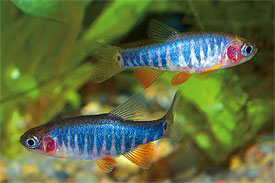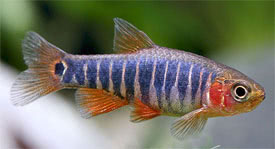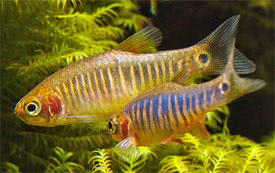
 Magyarul / Hungarian
Magyarul / Hungarian



- Scientific name: Celestichthys erythromicron
- Synonyms: Danio erythromicron, Microrasbora erythromicron
- Common name: Emerald Dwarf Rasbora
- Group: Cyprinids
- Habitat: Asia; Myanmar (Burma)
- Size: 2 cm
- Biotope: Found in eastern Myanmar, in lake Inle. It is an isolated mountain lake almost 900m above sea level with clear, shallow water and with loamy substrate and dense aquatic vegetation.
- Social behavior: A peaceful and active shoaling fish, ideal for community tanks. Males develop a pecking order among themselves. Can be kept with similar sized fish. In larger groups (15-20 fish) the aggression is spread between individuals and the fish are bolder.
- Diet: Omnivorous; in nature they eat small invertebrates, algae and zooplankton. In the aquarium they accept everything: live, frozen and flake foods too.
- Breeding: Quite easy
- Tank: Minimum 30 litres
- Population: 5-6 fish for 40 litres
- Decoration: They deserve a heavily-planted tank. Use dark gravel substrate with some larger smooth rocks. Use air powered sponge-filtration.
- Temperature: 20-24 °C
- pH: 7-8
- Hardness: 8-12 NK°
- Lifespan: 3 years
Description: Though the species was described in 1918, even today, it is not a common fish. Danio erythromicron is a pinkish-orange fish with up to 15 emerald green bars along its side. There is a black spot at the base of the caudal fin. In their natural habitat fishermen catch them with special traps placed among the plants overnight, because it is very hard to catch them with a net.
Mature females are a little larger and plumper. Males are more brightly colored, with well-defined, blue vertical bars on the flanks and red coloration in the fins. Like many small cyprinids, Emerald Dwarf Rasbora is an egg-scatterer spawner, with no parental care. Well-fed fish will usually spawn, and it is possible that a small numbers of fry survive in the community tank. They can be bred in pairs or in groups in a small (12-15 litres), dimly lighted tank. Add some java moss or spawning mops to the breeding tank. A female will lay about 30 adhesive eggs, among the plants. After spawning the parents should be removed as they will eat the eggs, and the females need a recovery period before next spawn. The eggs hatch after 72 hours and the fry become free-swimming after 3-4 days later. Feed them with infusoria or liquid foods. Larger fry can be fed with newly hatched brine shrimp.



